Interesting Things
ZWEMBALKONS HOTEL CONCEPT – MUMBAI
ZWEMBALKONS HOTEL CONCEPT – MUMBAI
‘Zwembalkons’ literally translates to ‘Swim Balcony’ in Dutch, and
the renderings showcase what is in the pipeline – A hotel concept with
the boldest of designs, featuring swimming pools surrounded by glass in
place of balconies.The 37 storey building would house 200 apartment rooms, three levels of car parking alongside a gym and sauna.
We think it’ll be a great reason to book a stay in India. We’ll await confirmation that the hotel has had the go ahead!



(168
An Apple Red as a Rose, Through and Through
For years, maybe centuries, the red apple has stood as the emblem
of everything from goodness to sin. The red apple is a stand in for
desire as well as the nickname for New York City (OK, it is the “Big
Apple” but everyone knows it is a decidedly red apple and no Granny
Smith). Now comes news from the UK (by way of Switzerland) that apple
breeder Markus Kobelt has lovingly developed a red-skinned and
red-fleshed apple called the Redlove Era.
Unlike the white flesh you may have grown accustomed to, the Redlove
Era has a sort of reddish-pink marbled flesh (with a bit of white flesh
thrown in for the sake of contrast) and as a result (maybe not a direct
result) the Redlove Era (an alleged cross-pollination of Royal Gala and
Braeburn apples) has a higher antioxidant content (there still exists a
bit of mystery around this particular variety). Another key selling
point for this red apple is that the flesh purportedly doesn’t go brown
after being sliced and left out in the open. Also, the Redlove Era is
supposedly sweet, tangy and amazingly delicious.
The sad news is that, while UK shoppers can look forward to biting the Redlove in the coming months, we Americans, hungry for red flesh, may have to wait a year or longer for the import. For those of you that are enormously curious (or impatient) and just can’t wait for a taste, you could order a sapling and possibly grow your own.
Redlove Era apples are being marketed by Suttons in the UK, and will hopefully make their U.S. debut in the coming year.
The sad news is that, while UK shoppers can look forward to biting the Redlove in the coming months, we Americans, hungry for red flesh, may have to wait a year or longer for the import. For those of you that are enormously curious (or impatient) and just can’t wait for a taste, you could order a sapling and possibly grow your own.
Redlove Era apples are being marketed by Suttons in the UK, and will hopefully make their U.S. debut in the coming year.
Photo Credit: BNPS.co.uk
(5)Dubrovnik, Croatia
Dubrovnik is a city of Croatia on the coast of the Adriatic Sea which
is famous for its historical monuments dating from the Middle Ages. Its
population is 49,000. Croatia significantly suffered from Serbian
attacts and its historical monuments damaged during the civil war in
Yugoslavia in 1991. City gained its old look with restoration work
initiated by UNESCO in 2005. The beach and Lokrum island which is famous
for its botanical gardens, the cathedral and Dubrovnik city walls
surrounding the city are famous tourist attractions.

 (5)
(5)

 (5)
(5)
SOME OF THE WORLD’S MOST BEAUTIFUL TREES
Huge 750 years old sequoia tree, California. Photo by: Michael Nichols
Beautiful wisteria tree. Photo by: Brian Young
Tree tunnel, Portugal.
Sagano bamboo forest, Kyoto, Japan. Photo by: Ingeun Nam
Central Park, New York. Photo by: Christopher Schoenbohm
Kiss under a cherry blossom tree. Photo by: Korri Crowley
(3)
Beautiful wisteria tree. Photo by: Brian Young
Tree tunnel, Portugal.
Sagano bamboo forest, Kyoto, Japan. Photo by: Ingeun Nam
Central Park, New York. Photo by: Christopher Schoenbohm
Kiss under a cherry blossom tree. Photo by: Korri Crowley
(3)
The 13 World’s Strangest And Funniest Buildings!
#13 – Puzzling World, Wanaka, New Zeland
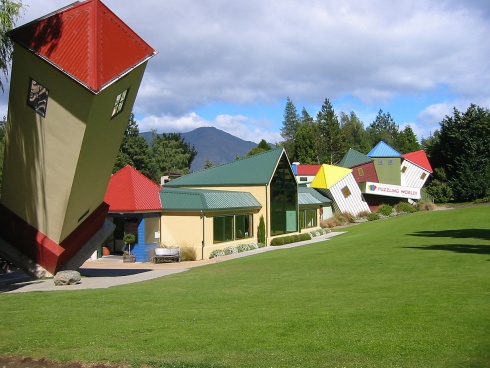
Stuart Landsborough’s Puzzling World is a tourist attraction near Wanaka, New Zealand. It started out as just a single level maze in 1973, but over the years expanded to add overbridges to the maze design (thus creating the world’s first 3-D maze), a large “puzzling café” where guests could try out several puzzles, five large rooms of optical illusions, the Leaning Tower of Wanaka (which has a backwards clock that was started on the eve of the new millennium) and other attractions (such as the Roman Bathrooms) that ascribe to their theme of “puzzling eccentricity”.
#12 – Upside Down House, Gettorf, Germany

This upside down house was built in March 2010 for a local zoo in Gettorf, Germany.
#11 – Cybertecture Egg, Mumbai, India
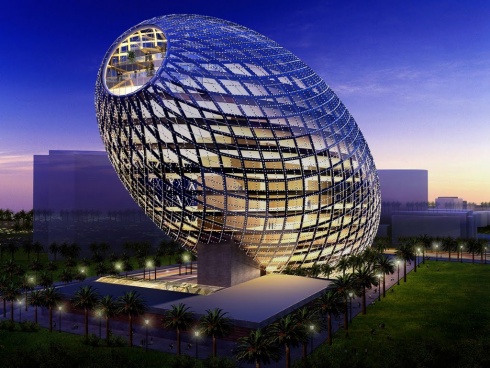
A new form of architecture, commissioned by Vijay Associates (Wadhwa Developers) and designed by James Law Cybertecture International and Ove Arup, is typified by new intangible materials of technology, multimedia, intelligence and interactivity to create an awe-inspiring landmark for the city of Mumbai and for India in the 21st Century.
#10 – The Teapot Dome, Zillah, USA

The Teapot Dome Service Center located in Zillah, Washington, and in 1985 listed on the U.S. National Register of Historic Places.
#9 – Kunsthaus Graz, Austria
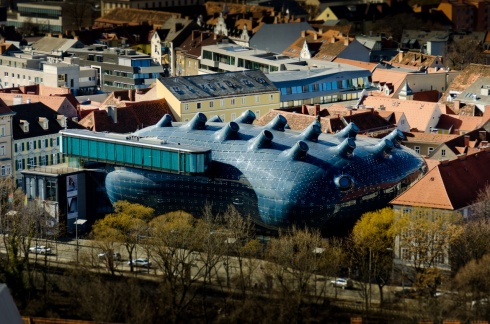
The Museum of Contemporary Art in Graz was built in 2003. Designed by architects Peter Cook and Colin Fournier in an innovative style known as blob architecture, focusing on the creation of “living” structures similar to a huge drop or bubble. Though it looks like an ameba, it’s called “Friendly Alien”.
#8 – Dog Bark Park Inn, Idaho, USA
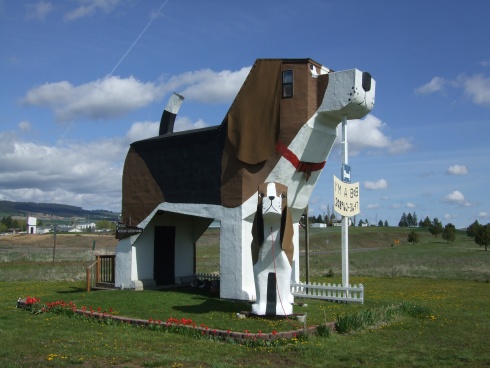
The Dog Bark Park Inn is a hotel located in the US state of Idaho. The hotel is built in the shape of a beagle, making it a famous landmark in the state. It is colloquially known as Sweet Willy by local residents. The hotel, which is located in north central Idaho, is a two-bedroom B&B which also features dog-themed contents.
#7 – The Spittelau Waste Incineration Plant, Vienna, Austria
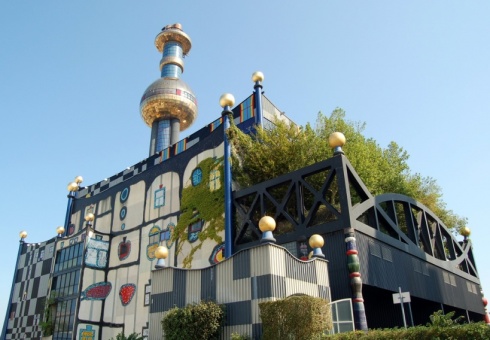
The Spittelau Incinerator is a waste-to-energy incinerator in Vienna, Austria. Originally completed in 1971 the building was damaged by fire and in 1987 the elevations were redesigned by architect and artist Friedensreich Hundertwasser.
#6 – Ripley’s Believe It or Not! Atlantic City, NJ, USA

As of 2010, there are over 30 “Ripley’s Believe It or Not!” Museums, or more correctly Odditoriums (from Oddity – someone or something strange or unusual) around the world. “Ripley’s Believe It or Not!” is a franchise, founded by Robert LeRoy Riply (1890-1949), an American cartoonist, entrepreneur and amateur anthropologist. The first Ripley’s Odditorium” collection was displayed during the run of the World’s Fair in 1933 in Chicago, and in 1950, a year after Ripley’s death, the first permanent Odditorium opened in St. Augustine, Florida.
#5 – Tianzi Hotel, Langfang, China
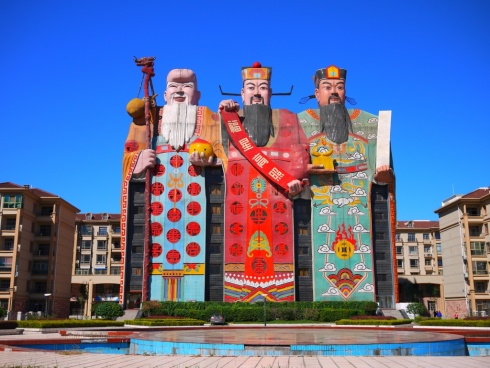
This ten-storey building in the shape of three huge Heroes is nothing but the Tianzi Hotel that was built in 2000 in the Chinese city of Langfang, Hebei Province, between Beijing and Tianjin.
#4 – Robot Building, Bangkok, Thailand
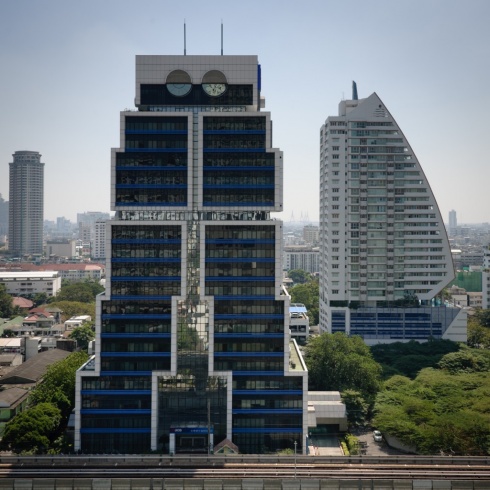
The Robot Building, located in the Sathorn business district of Bangkok, Thailand, houses United Overseas Bank’s Bangkok headquarters. It was designed for the Bank of Asia by Sumet Jumsai to reflect the computerization of banking; its architecture is a reaction against neoclassical and high-tech postmodern architecture. The building’s features, such as progressively receding walls, antennas, and eyes, contribute to its robotic appearance and to its practical function. Completed in 1986, the building is one of the last examples of modern architecture in Bangkok.
#3 – The Torre Galatea, Figueres, Catalonia, Spain

The Dali Theatre and Museum, Torre Galatea in Figueres, Spain – the home town of famous artist Salvador Dali. It has a very unusual architecture with several egg shaped sculptures on its roof. Dali had spent later part of his life in Torre Galatea, which he had named after his wife Gala.
#2 – Wall House, Odessa, Ukraine

Wall House was built about 150 years ago. At first it seems to be built only for thin people, but in fact the secret of architectural deception was revealed: the back wall of the house is at a sharp angle, it is directly adjacent to a facade, and, as a matter of fact, the house has a triangular shape.
#1 – Museum of Contemporary Art, Niteroi, Brazil
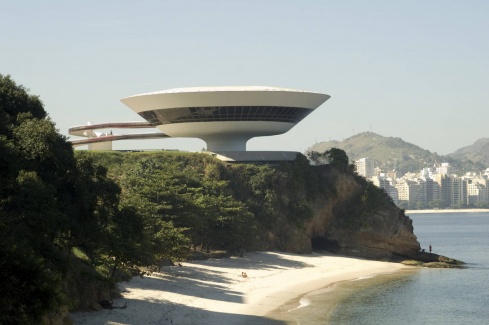
Designed by Oscar Niemeyer with the assistance of structural engineer Bruno Contarini, who had worked with Niemeyer on earlier projects, the MAC-Niterói is 16 meters high; its cupola has a diameter of 50 metres with three floors. The museum projects itself over Boa Viagem (“Bon Voyage,” “Good Journey”), the 817 square metres (8,790 sq ft) reflecting pool that surrounds the cylindrical base “like a flower,” in the words of Niemeyer.
Northern Lights over an Erupting Volcano
In April 2010, the Icelandic volcano Eyjafjallajökull spewed great ash
clouds into the sky and caused enormous disruptions to air travel in
Europe. The eruptions are best remembered for this inconvenience, but
photographer James Appleton managed to capture the event in a different
way. In the weeks before the disturbances, a vulcanologist friend of his
alerted him to the unfolding volcanic drama, and Appleton travelled
straight to the Icelandic mountain before it was closed off. Risking his
life to battle extreme cold, high winds, and seismic activity, Appleton
captured a rare but gorgeous scene: the glowing lava from an
Eyjafjallajökull fissure with the Northern Lights… (66)
Subscribe to:
Posts (Atom)






